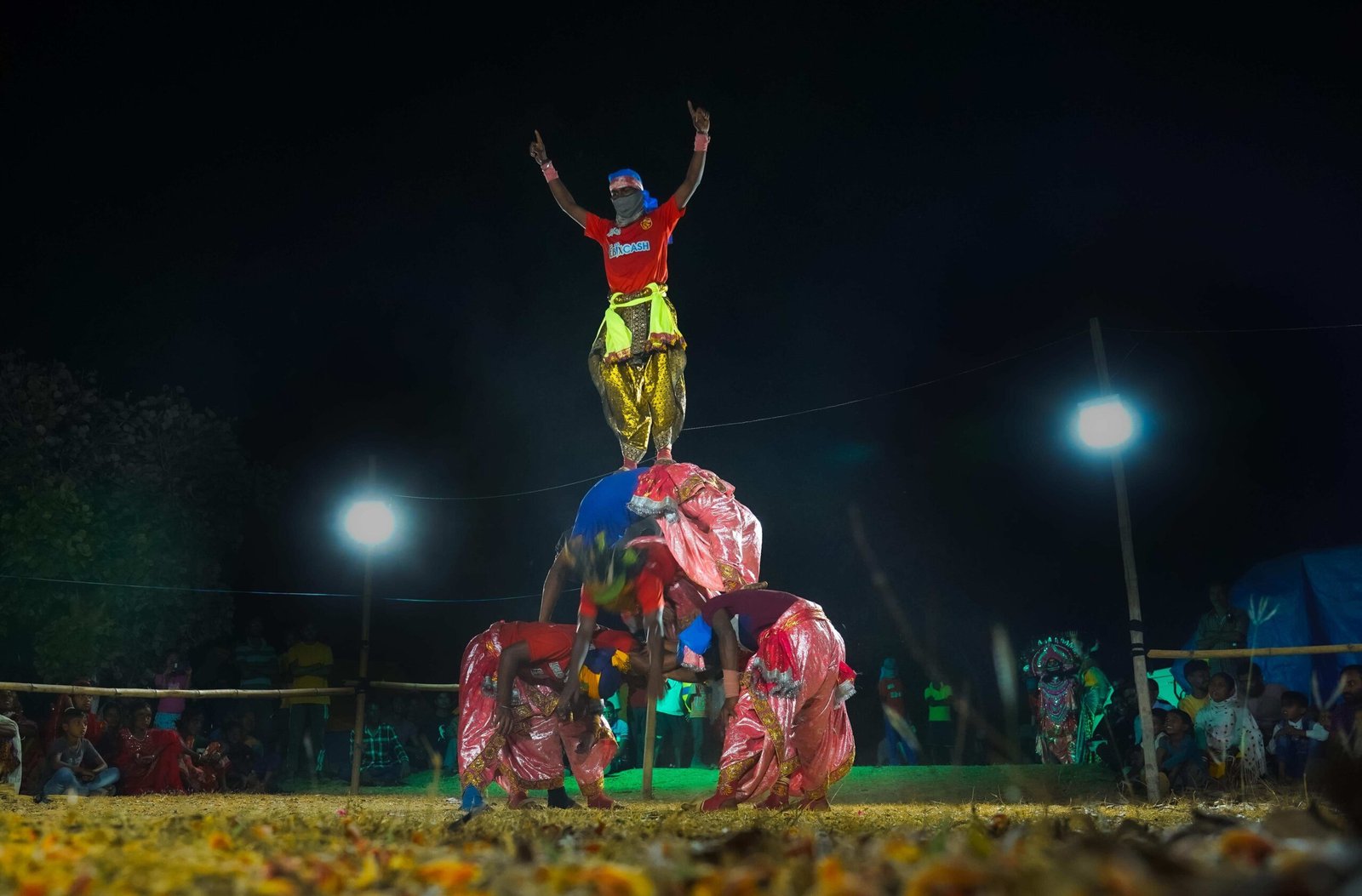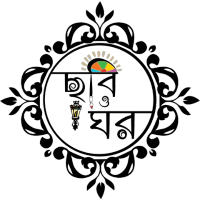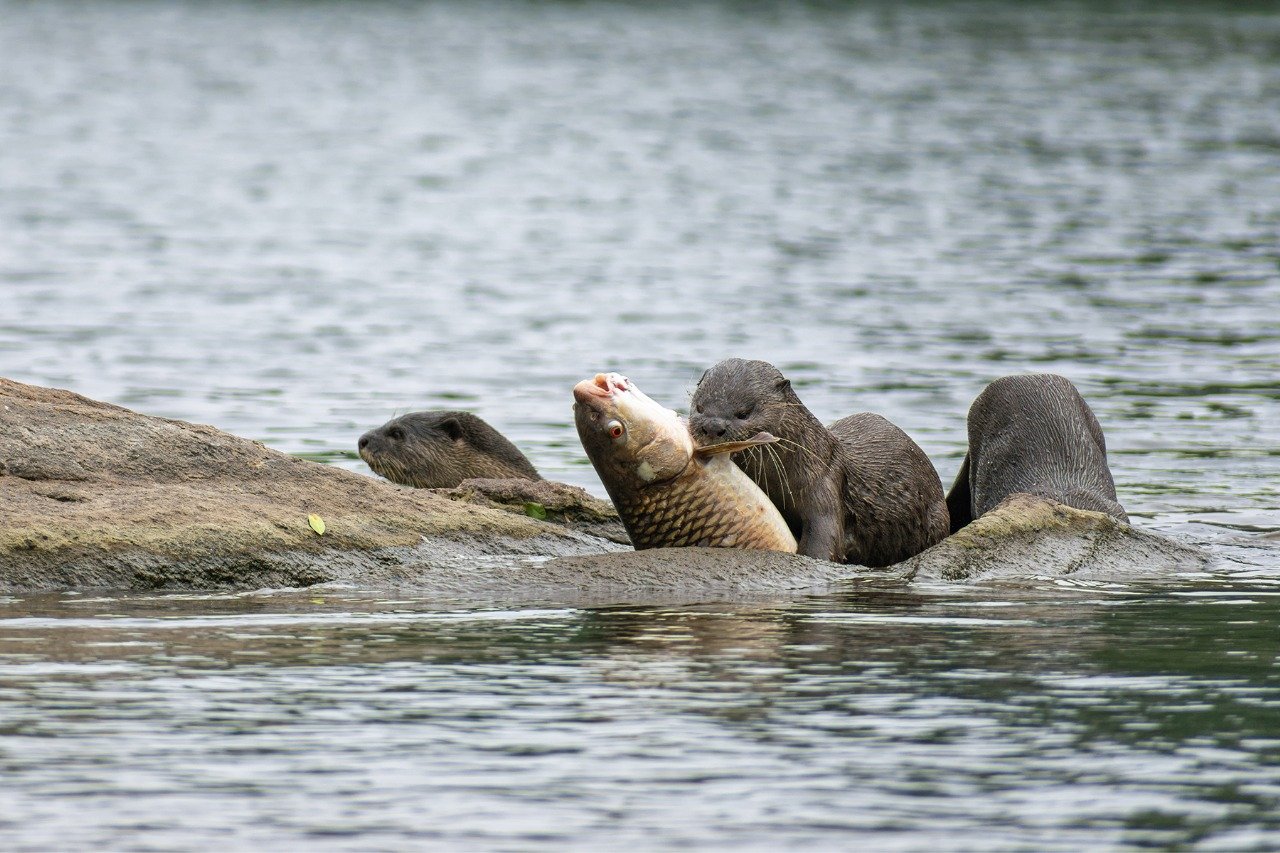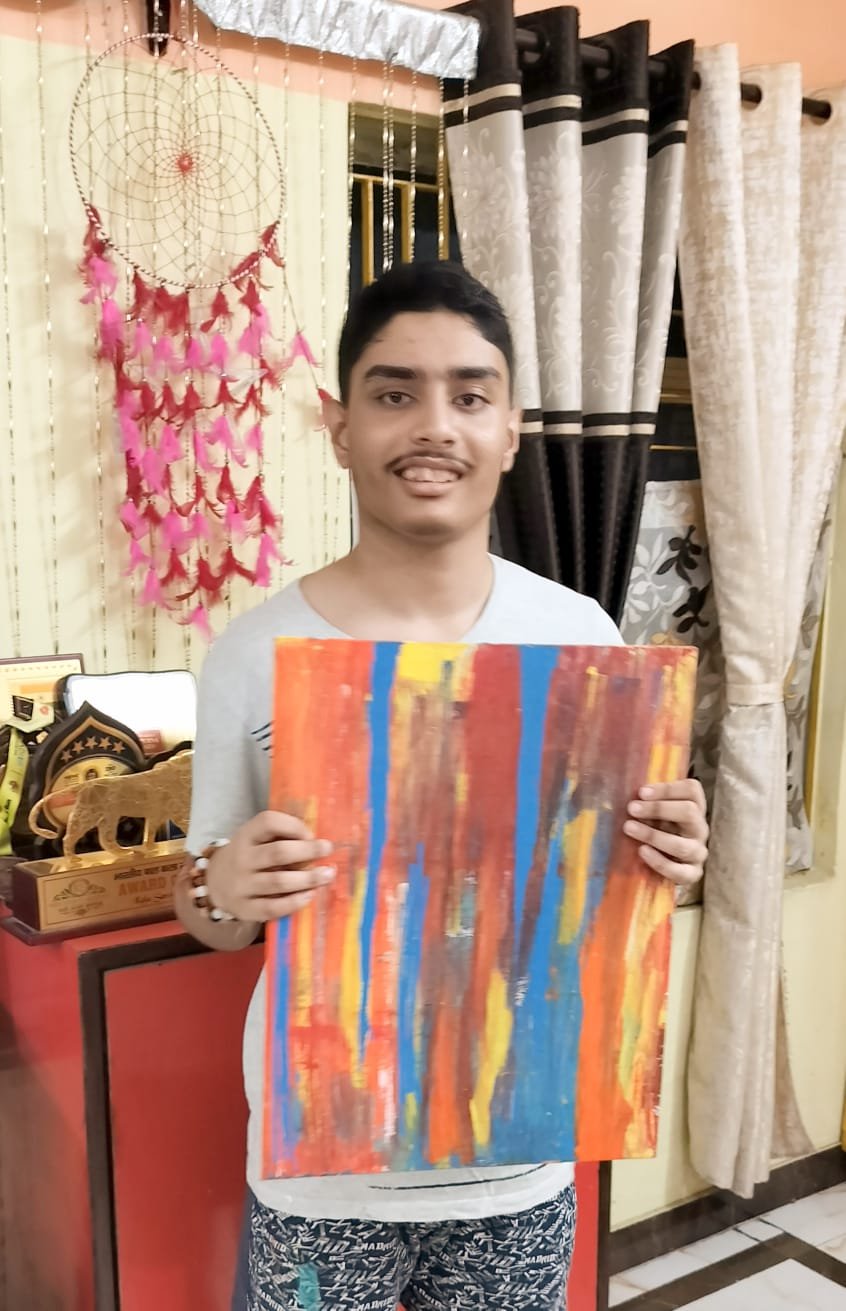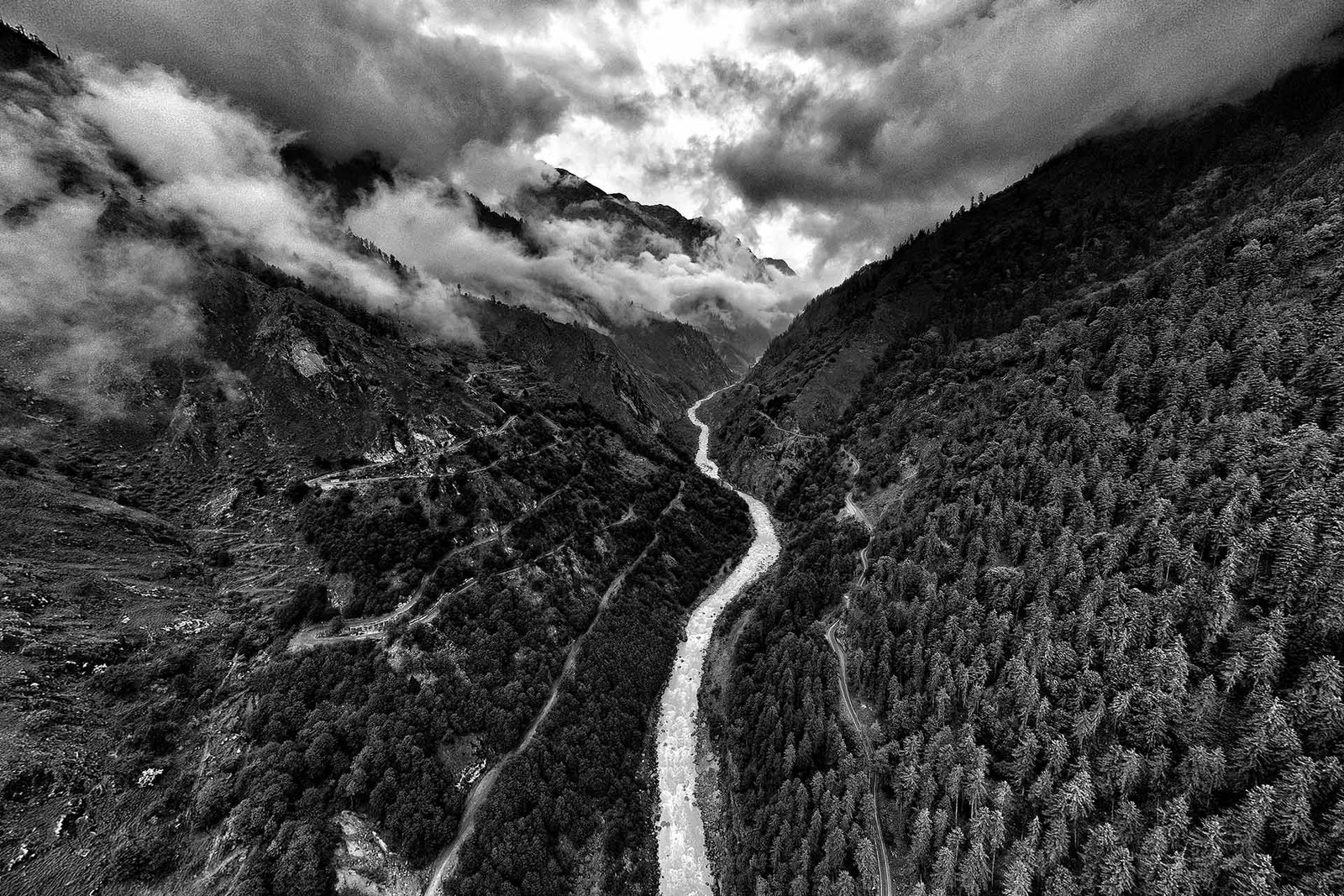Chhau Dance — or ছৌ নাচ as it is known in Bengal — is not merely a performance, but a living rhythm rooted in the soil of eastern India. With its acrobatic movements, mythological storytelling, and striking masked choreography, Chhau stands at the intersection of folk tradition, martial arts, and ritual expression. Among its regional forms, the Purulia Chhau of West Bengal holds a distinct place — colourful, vigorous, deeply connected to rural life.
Recently, after one of our public performances, a guest came up and asked — “How can we see this again in Kolkata?” Another wanted to know, “Can I invite this team to my school?” These questions are not rare. In fact, they reflect a growing curiosity and admiration for traditional Indian dance forms that go beyond the classical circuit. Chhau, in particular, bridges the divide between the village and the city, past and present.
In this blog, we explore the essence of Chhau, its cultural origins in Bengal’s Purulia district, and the story of the artists who carry this torch forward. We also share how cultural organisations like ours are creating a space for these voices — and how you can be a part of it.
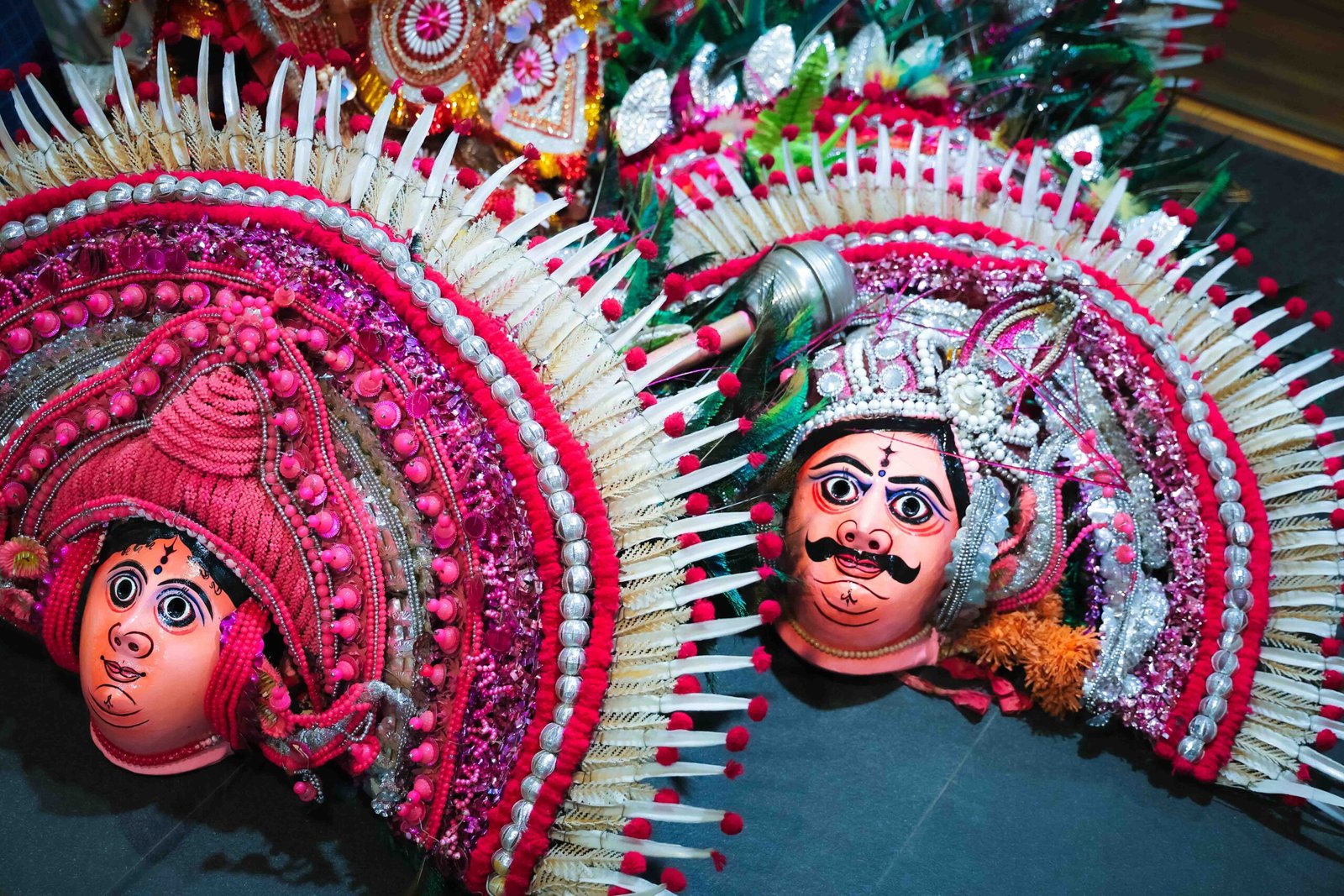
Origins of Chhau Dance: Where the Earth Becomes Theatre
The roots of Chhau Dance (ছৌ নাচ) stretch deep into the red laterite soil of Bengal, Jharkhand, and Odisha. Among the three primary variants — Purulia Chhau (West Bengal), Seraikela Chhau (Jharkhand), and Mayurbhanj Chhau (Odisha) — it is the Purulia style that is most theatrically rich and visually commanding. With its vigorous body movements, bold expressions, and use of elaborate masks, Purulia Chhau has become emblematic of Bengal’s rural folk performance culture.
Historically, Chhau is believed to have evolved as a form of martial dance, blending indigenous battle techniques with mythological narratives. Its name possibly derives from the Sanskrit word Chhaya (meaning shadow or mask), or the Odia word Chhau (meaning stealth). Over time, it absorbed local tales, ritualistic elements from tribal communities, and devotional themes from Hindu epics such as the Ramayana, Mahabharata, and Puranas.
What makes Purulia Chhau unique is its village-grounded nature — it is still performed under open skies, during festivals like Charak and Gajan, often accompanied by the pulsating rhythm of dhamsa and madol. These dances are not stage-bound; they are part of community gatherings, harvest celebrations, and spiritual observances. And unlike classical Indian dance forms, Chhau was not born in the court or temple — it emerged from the people, for the people.
Today, it stands as a folk-theatrical expression of Bengal’s agrarian imagination, nurtured by generations of rural artists.
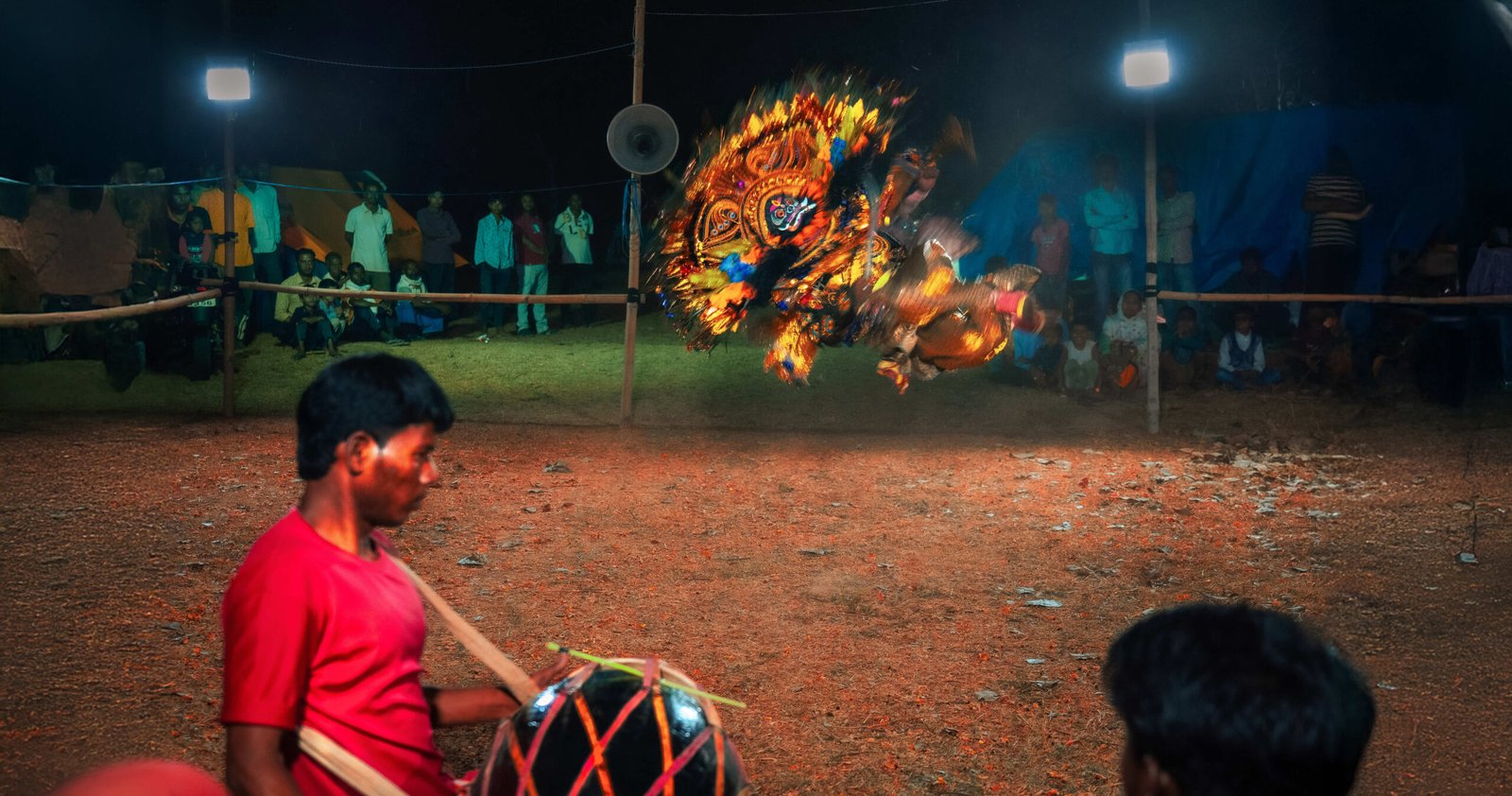
The Role of Masks: The Soul of Chhau
If Chhau Dance is the body, the mask (মুখোশ) is its soul. Especially in Purulia Chhau, the use of ornate, hand-crafted masks transforms the performer into gods, demons, animals, and celestial beings. These masks are not mere props—they are powerful carriers of identity, metaphor, and regional artistry.
The heart of mask-making lies in Charida, a small village nestled in the Ayodhya Hills of Purulia district. Often called the “Mask Village”, Charida is home to over 150 artisan families who have, for generations, dedicated themselves to this living craft. Made from layers of clay, cloth, and papier-mâché, these masks are then dried, painted in vivid colors, and adorned with elaborate decorations—each a meticulous tribute to character and story.
The Durga mask, with its majestic crown and calm ferocity; the Ravana mask, multi-headed and expressive; or the Hanuman mask, full of life and movement—each has its own energy and role to play. These masks are not generic. They are coded with regional beliefs, iconographic detail, and a performative grammar that dancers embody during each act.
In Bengal’s rural festivals, a young boy wearing a lion’s mask does not merely play a lion—he becomes it. This transformation is central to Chhau. The dancer’s identity dissolves into the character; the mask allows that passage. In fact, many dancers begin the performance only after ceremonially placing the mask on their heads, invoking the spirit of the role.
The journey of each Chhau performance begins in the quiet corners of Charida, where art, history, and devotion blend into a face that will speak, fight, pray, and dance.
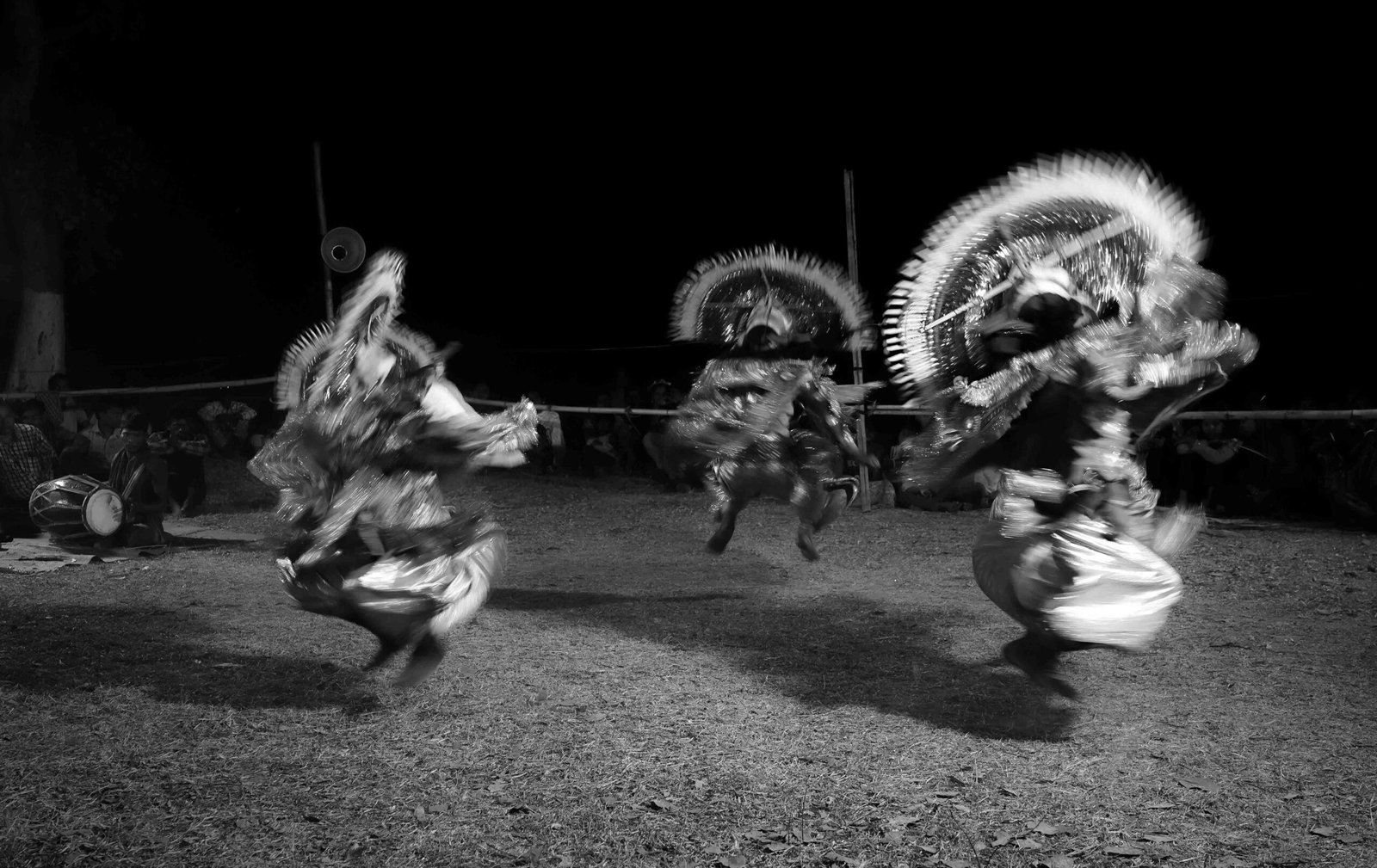
Themes, Stories, and Symbolism in Chhau Dance
At the core of Chhau lies an epic imagination. It is where movement becomes myth, and myth becomes a living, breathing presence on stage. The themes of Chhau performances—particularly in Purulia Chhau—are often drawn from Indian epics like the Ramayana, Mahabharata, and Puranas, but they are never confined to mere retelling.
In the hands (and feet) of Chhau performers, Durjodhon becomes not just a warrior, but a metaphor of pride and downfall. Ram is not only a god, but the embodiment of dharma. These characters are rendered with such physicality—through leaps, martial flips, spins, and graceful stances—that even audiences unfamiliar with the source text can feel the tension, glory, and conflict unfold.
But Chhau is not just about gods and demons. Its symbolism runs deeper. A peacock dance may reflect longing. A lion may not only show power but also the wild unpredictability of fate. The thunderous drumming and sudden stillness echo emotional transitions—from wrath to surrender, from chaos to transcendence.
Color, rhythm, and gesture form a semiotic triangle in Chhau. A red mask signals rage or divine force; a deep bend of the body represents humility or submission. Every step has its intention—not decorative, but communicative.
And increasingly, contemporary Chhau groups are exploring environmental themes, tribal myths, and even social issues—bringing a fresh relevance to ancient techniques. Teams like Durjodhon Mahato’s group, for instance, while steeped in tradition, are also open to experimental narratives and collaborative storytelling.
In this way, Chhau remains both timeless and timely. It connects today’s viewer to ancestral memory while reminding us that folk expression can evolve without losing its essence.
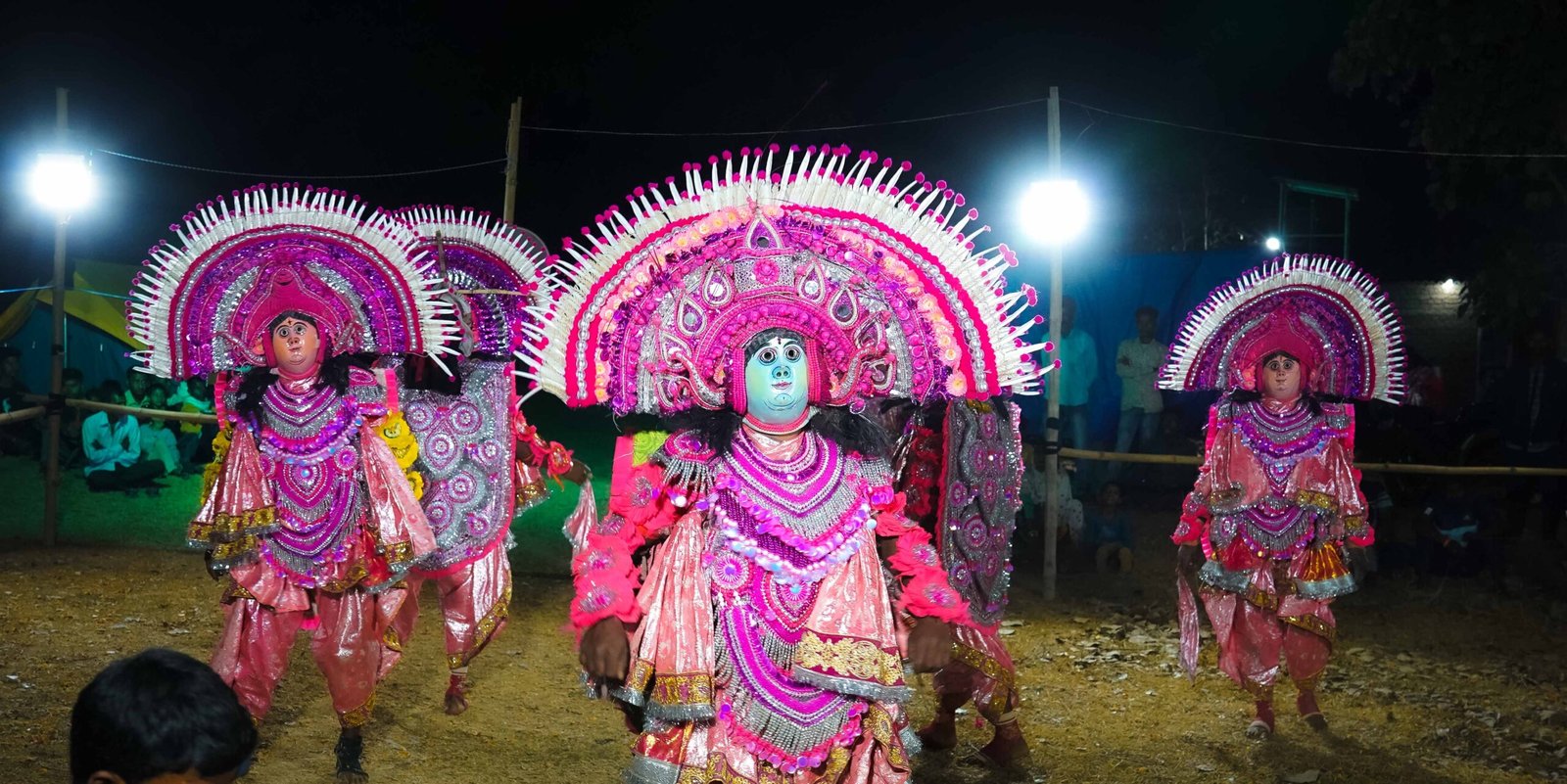
Training, Music, and the Art of Preparation?
To the casual viewer, Chhau may appear as a dazzling burst of energy and spectacle. But behind each performance lies a demanding discipline—one forged through years of physical training, musical rigour, and deep cultural immersion.
Physical Training
Most Chhau performers, especially in Purulia, begin training at a very young age. They are trained not in studios but often in open fields or akharas, where their bodies adapt to the rhythm of earth and wind. The acrobatics—vaulting into air, diving into somersaults, and spinning with arms outstretched—require intense core strength, balance, and stamina.
Practices usually start at dawn, sometimes before the first light cracks open the sky. Footwork is honed barefoot on hard soil. Breathing is disciplined. Body control is cultivated like a martial art, which in essence, Chhau partly is.
Music and Rhythm
No Chhau performance exists without its live musical backbone. The dhol, dhamsa, and shehnai form the primary triad of instruments. Their sounds are not mere background—they drive the performance forward, creating cues for entry, exit, combat, grace, and surrender.
The dhol mimics thunder, charging the performer’s body with anticipation. The shehnai, often played with haunting sweetness, introduces moments of devotion or melancholy. There is a rhythmic script, almost coded, that only the dancer and musician understand—and they follow it like a map through storm and serenity.
The Mask-Making Ritual
Every dancer has a partner before the audience arrives—their mask. Most masks are handcrafted in Charida, a remote artisan village in Purulia, where over 200 families are involved in the craft of mask-making (ছৌ মুখোশ). Made from papier-mâché, clay, and natural paint, each mask is a labour of tradition and identity.
The mask does not merely adorn the dancer’s face—it transforms them. The moment a performer dons it, they become Rama, Mahishasura, or Narasimha. Their body becomes a canvas and the mask, a soul.
Wearing the mask also imposes a limitation—the face cannot emote, so every emotion must be channelled through posture, gesture, rhythm, and presence. This is what makes Chhau a masterclass in non-verbal expression.
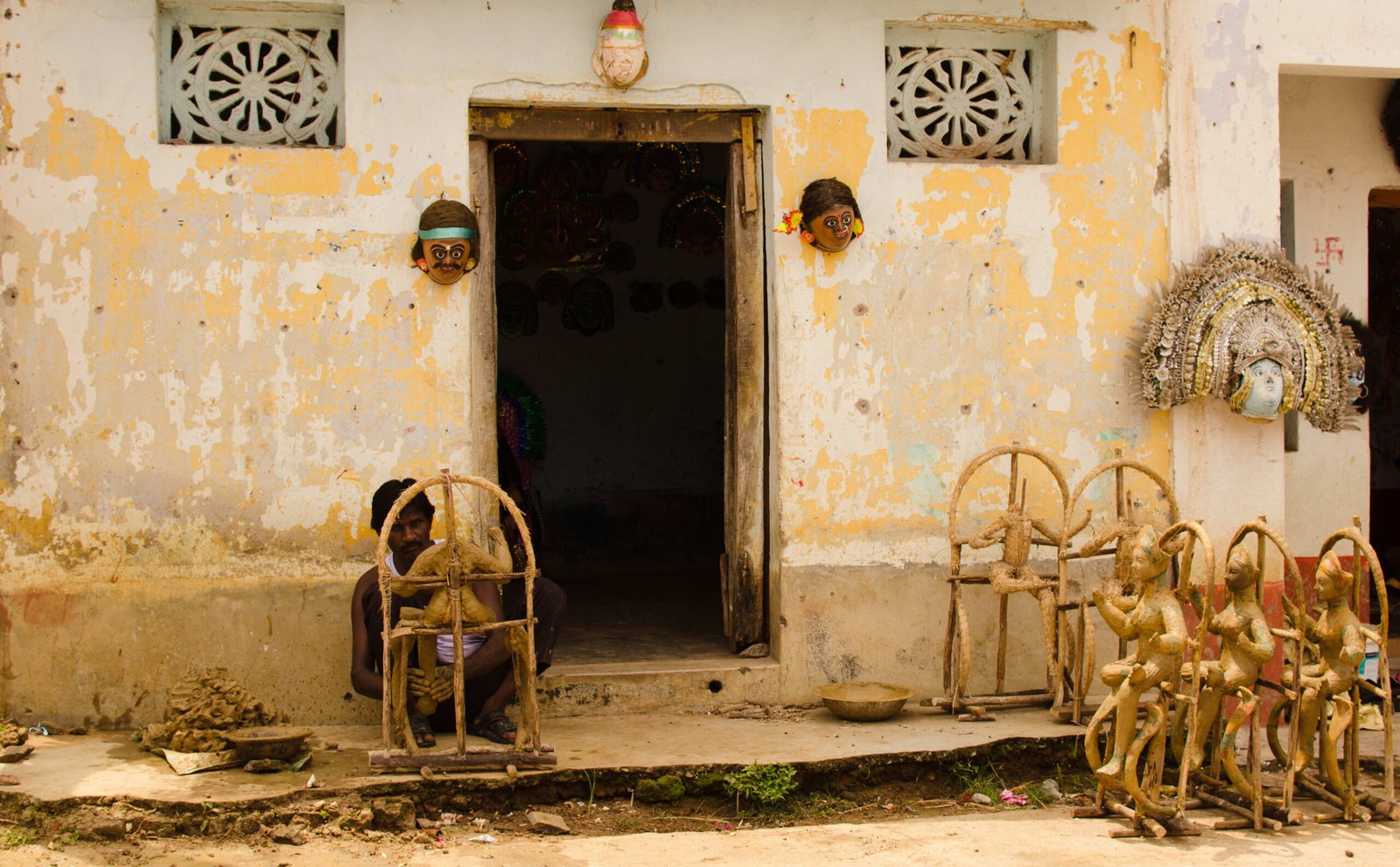
Charida – The Mask Village of Bengal
Hidden at the edge of the Ayodhya Hills in Purulia lies a quiet village that has shaped the visual identity of Chhau for centuries—Charida (চরিদা). Here, masks are not merely crafted; they are consecrated through labour, memory, and generational knowledge.
A Village Built on Faces
Walk into Charida and you’ll find rows of masks drying under the sun—faces of gods, demons, and celestial warriors staring back at you. Over 200 artisan families call this village home, and for them, mask-making is not just a livelihood—it is their heritage. Most of them belong to the Sutradhar community, traditionally associated with woodcraft and sculpture.
The process is meticulous. A mask begins with a clay mold, which is layered with papier-mâché, jute, and cotton cloth. Once dried and hardened, it is carefully detached and then hand-painted with vivid hues—reds, golds, blues, and greens—each denoting a mythic role or emotional tone. Ornamentation with sequins, mirrors, and feathers further elevate the mask’s theatrical presence.
Artisans as Cultural Carriers
These artisans rarely perform Chhau themselves, yet their hands shape the face of the performance. Each mask carries with it not only a character but also a story—the artisan’s own memory, an ancestral style, or an incident from a village Jatra. Many of them have trained under family elders and now pass on the techniques to their children.
Durjodhon Mahato, the performer whose group we recently invited, spoke about how he makes a pilgrimage to Charida before every new production. For him, selecting a mask is like choosing a face for his inner god—it must feel right in the hand, sit firmly on the head, and evoke transformation the moment it touches the skin.
Charida’s Global Footprint
In recent years, Charida has found recognition beyond Bengal. The masks are now exhibited in galleries, sold in fairs, and even featured in international museum collections. Yet, their primary life still begins and ends in Chhau.
This quiet village has become a living museum, where tradition breathes beside innovation. If you ever visit, you may find a mask-maker humming a tune while brushing gold paint on a face of Mahadev, while his child paints a demon in fluorescent green beside him—both part of the same timeless story.
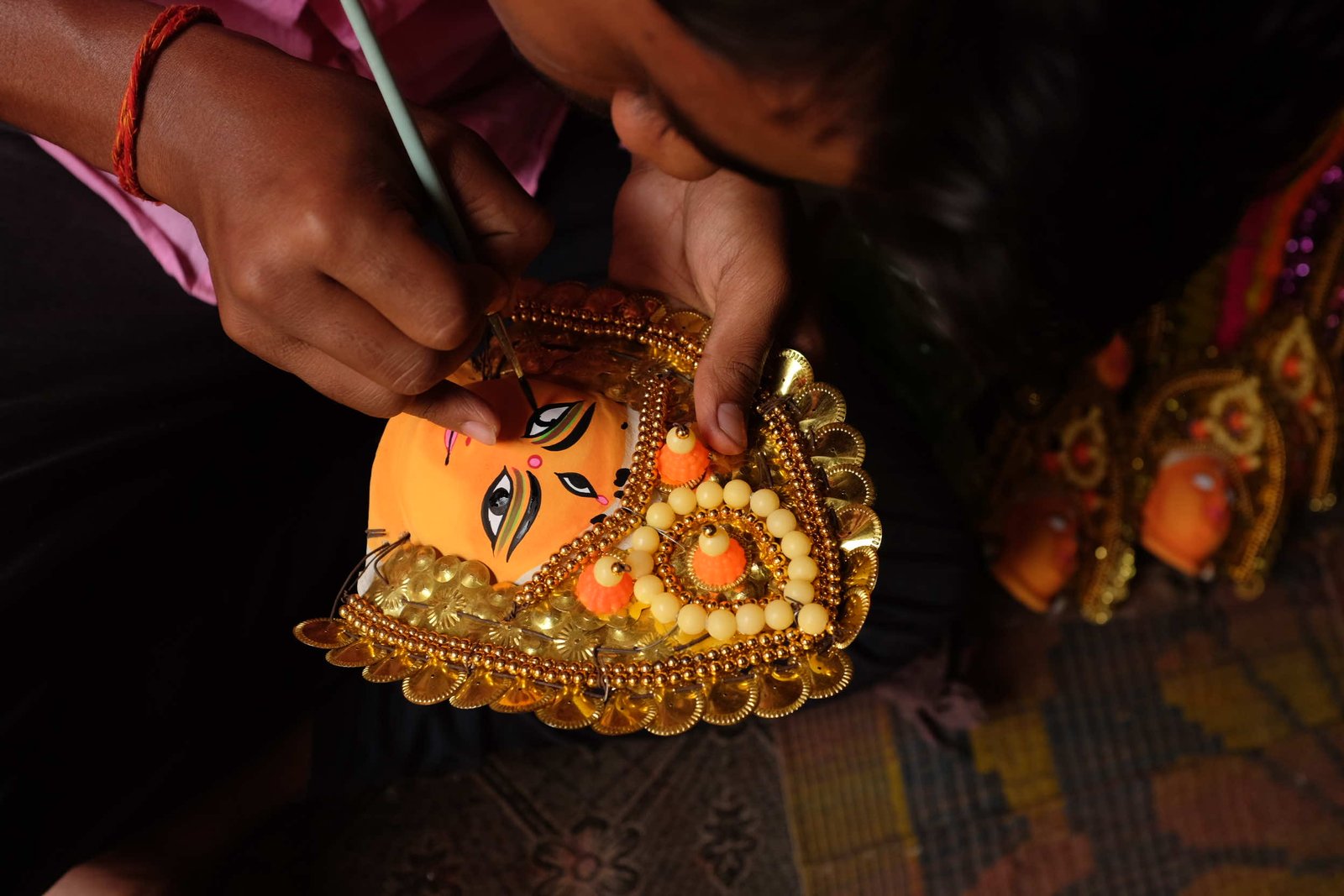
Themes and Characters in Chhau Dance
At its core, Chhau (ছৌ নাচ) is an epic in motion. Every leap, stomp, and spin embodies a tale—drawn from mythology, folklore, and agrarian life. It is a non-verbal narrative where movement replaces dialogue, and masks replace facial expression. Yet, the emotional depth it achieves is extraordinary.
Epic Roots and Divine Narratives
Traditionally, Purulia Chhau draws from the Mahabharata, Ramayana, and Puranas. Dances like Mahishasur Mardini, Shiva-Parvati, or Arjuna’s Archery are not just mythic enactments—they are performed embodiments of good, evil, love, rage, and penance. The larger-than-life masks help transform performers into gods and demons, giving the illusion of divine presence on earth.
Characters like Shiva are slow and meditative, their motions full of gravitas. In contrast, a character like Durga or Mahishasura demands fierce, energetic movements. Warriors perform somersaults, backflips, and sweeping turns, all while maintaining balance with the heavy headgear and elaborate costume.
Beyond Myth: Folk Tales and Agrarian Rhythms
Not all Chhau performances are mythological. Several compositions are based on local legends, hunting tales, or scenes from village life—a farmer tilling his field, a snake charmer teasing his cobra, or even the playful dance of a peacock in monsoon. These lighter themes are often performed during village fairs and harvest festivals, especially around Chaitra Parab.
In our recent interaction, Durjodhon Mahato shared how he is experimenting with hybrid forms—retelling myth through the lens of modern life, such as a battle between nature and pollution, using Chhau’s traditional vocabulary of movement.
The Dance of Silence
What makes Chhau unique is its absence of spoken word. The entire story unfolds through movement, music, and costume. This creates a universality that transcends language. An urban child in Kolkata, a visitor from Europe, and a tribal elder from Jharkhand can all follow the emotion of a Chhau performance without needing a single word of translation.
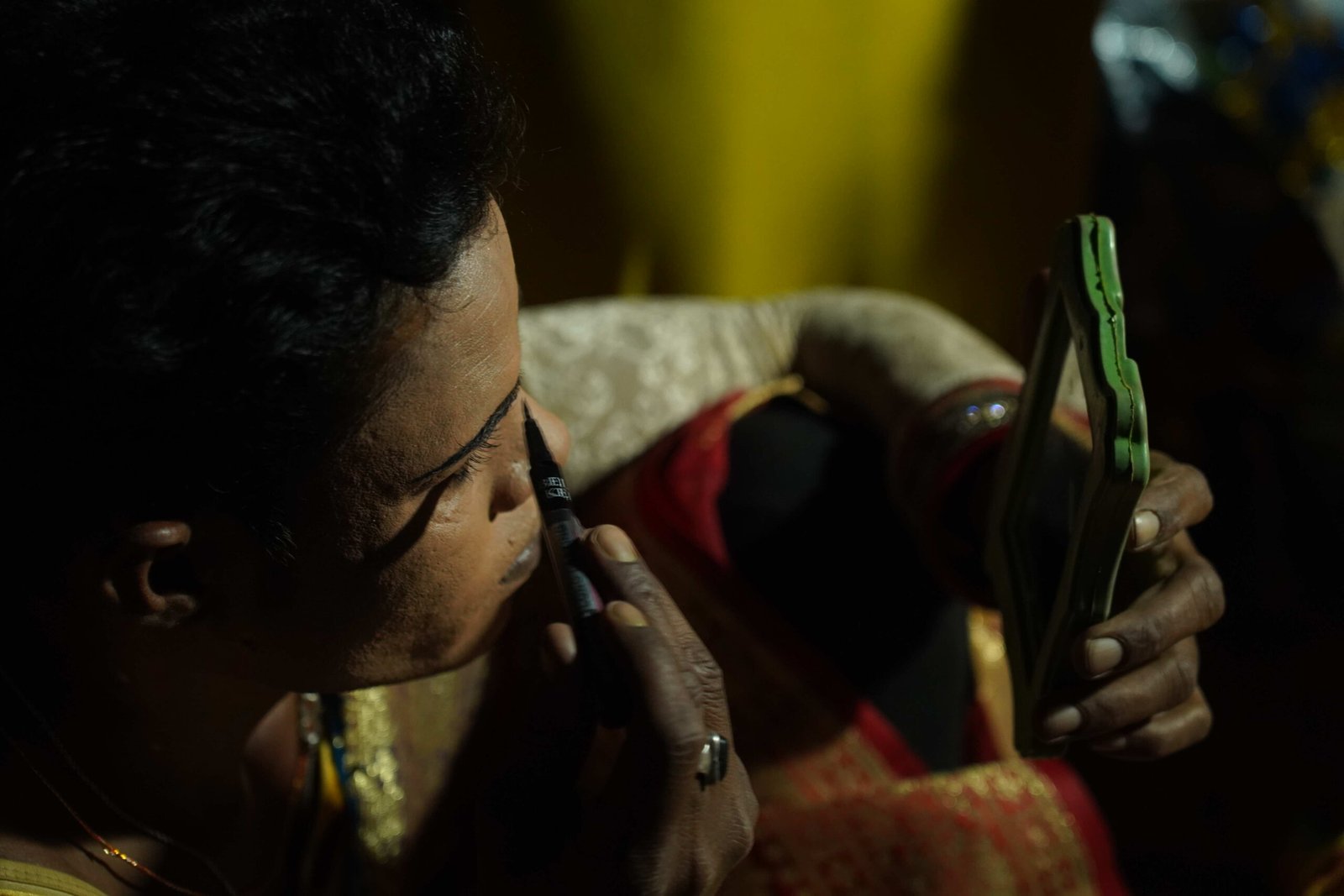
Music, Costume, and Performance Space
Chhau is not merely a dance—it is a total theatrical experience. The music, the costumes, the stage (or the lack of one), and the community setting—all contribute to the immersive magic that is Chhau. Every element is rooted in the soil of Purulia, where rhythm, color, and ritual blend seamlessly with daily life.
The Orchestra of the Earth
The soundscape of Chhau is elemental—no electronic synthesizers or flashy sound design. The instruments are traditional, acoustic, and raw. At the heart is the dhamsa, a large kettle drum with a deep bass that echoes like thunder, and the madal, a double-sided folk drum that provides the heartbeat. Supporting them are the shehnai and mohuri, reed instruments that produce piercing, melodic wails—evoking the emotional tones of battle, longing, or joy.
Music in Chhau is not background—it is dialogue. It signals shifts in character, tension in conflict, and resolution in harmony. The dancers respond in real time, interpreting beats like cues from a conductor.
Masks That Speak
Perhaps the most iconic visual of Purulia Chhau is its vibrant mask (মুখোশ)—handcrafted in Charida village, nestled at the foothills of Ajodhya Pahar. These masks are not just props; they are ritual objects. Each one is custom-made for a character and treated with reverence. The craft of mask-making is a full-time occupation for several families in Charida, passed down across generations.
The Durga mask may take 8–10 days to complete, involving clay moulding, jute layering, drying, and finally, painting in bold, vibrant strokes. A good mask not only resembles the deity—it commands attention, transforms the dancer, and stuns the audience.
Stage Without Walls
A traditional Chhau performance doesn’t need a proscenium stage. Often held during village festivals or melas, the performance area is a mud courtyard, open to sky and crowd. The audience sits or stands in a circle, forming a natural amphitheater. Fire torches, not floodlights, illuminate the night. Children watch wide-eyed from their parents’ laps. Drums roll, and suddenly the gods are in their midst.
In our curated event in Kolkata, we tried to preserve this openness—placing the dancers close to the audience, letting the masks, music, and movement carry the magic. And it worked. Urban viewers, unfamiliar with Chhau, stood silently captivated.
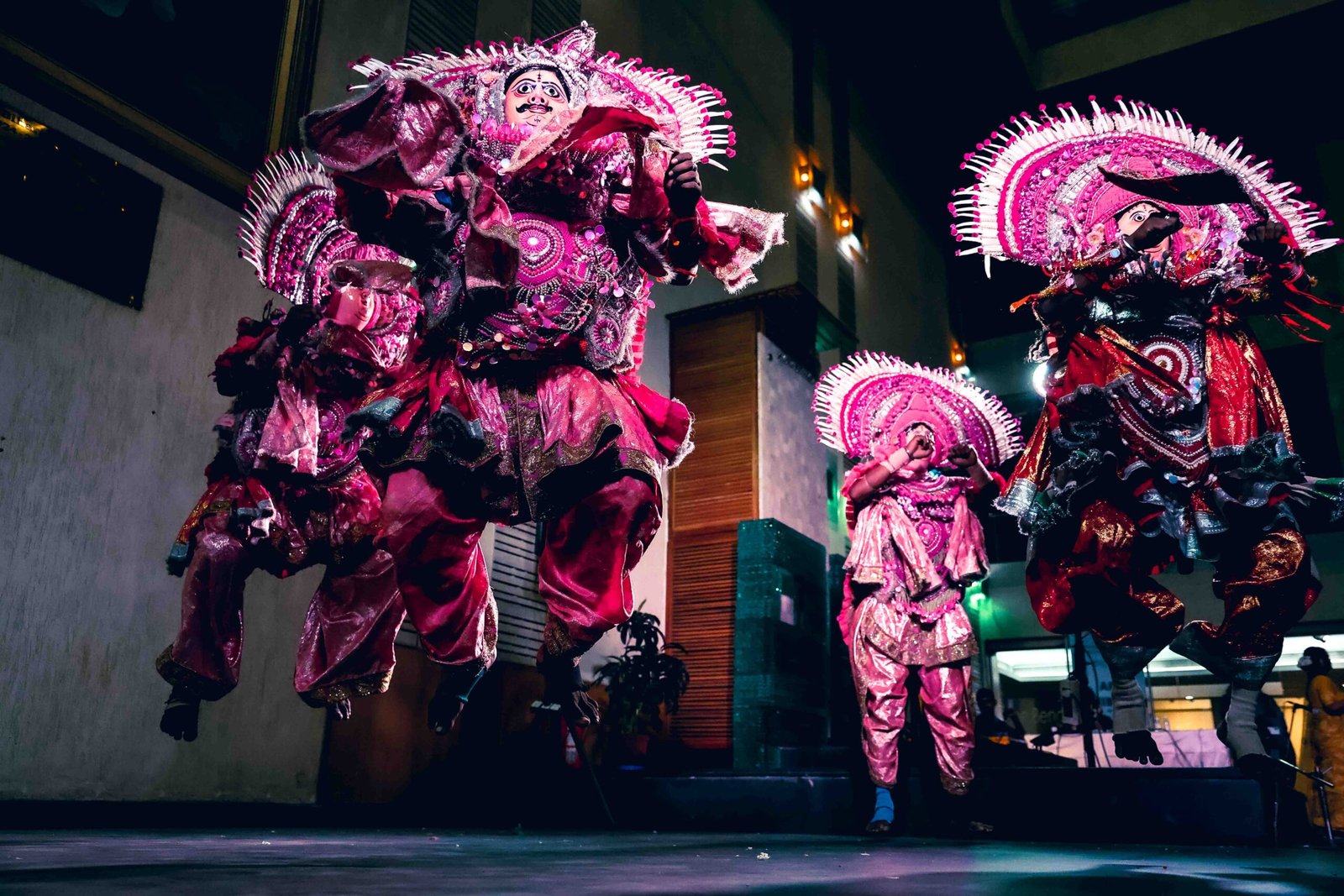
How to Organize a Chhau Performance Today
In recent years, there has been a rising interest among urban cultural organizers, educational institutions, and festival curators in bringing folk performances like Chhau into mainstream spaces. However, many are unsure of the logistics—how to contact the right group, how to ensure authenticity, and how to handle travel, performance setup, and remuneration.
As someone who has recently hosted a Chhau team and facilitated their performance, I often hear the question:
“Can we invite them for our event?”
The answer is—yes, and it is not as difficult as it seems.
Finding the Right Artists
There are many Chhau troupes across Purulia, but not all are performance-ready for curated city events. The key is to connect with a trained and authentic group, such as the one led by Durjodhon Mahato, an experienced Chhau master from the Jhalda subdivision of Purulia. His team has trained young dancers, musicians, and mask bearers who maintain high artistic and technical standards.
If you’re looking for a facilitator, we at COG India Art Foundation are happy to mediate and help plan a performance that suits your venue and audience.
Things to Consider
Stage Space:
Chhau requires open space. The dance is expansive and includes leaps, spins, and battlefield movements. A clear minimum of 15×15 feet is ideal, preferably with some distance from the audience for mask visibility.
Sound Setup:
Most Chhau teams bring their own traditional instruments and prefer not to use recorded music. You’ll need a basic amplification system with a couple of mics for larger halls. In outdoor spaces, no mic is often better—let the dhamsa speak.
Travel and Lodging:
Purulia is about 6–7 hours from Kolkata by road. Artists usually travel in groups of 12–15, including dancers, musicians, and support staff. Travel fare, and food must be provided in addition to performance fees. These are artists, not vendors.
Performance Duration:
A typical Chhau piece lasts 40–55 minutes, but can be extended with storytelling, mask-making demonstration, or workshops. Themes include episodes from the Mahabharata, Ramayana, and local folk legends, as well as harvest celebrations and tribal myths.
Honorarium:
Fees vary depending on the group size and travel logistics. A one-day event in Kolkata with full setup may range between ₹35,000–₹50,000, including transport in 2025. Please avoid bargaining. This is art, not commodity.
Cultural Context:
You’re not just booking a show—you’re hosting a piece of Bengal’s living folk heritage (লোক ঐতিহ্য). Please offer the artists a platform of dignity and hospitality.
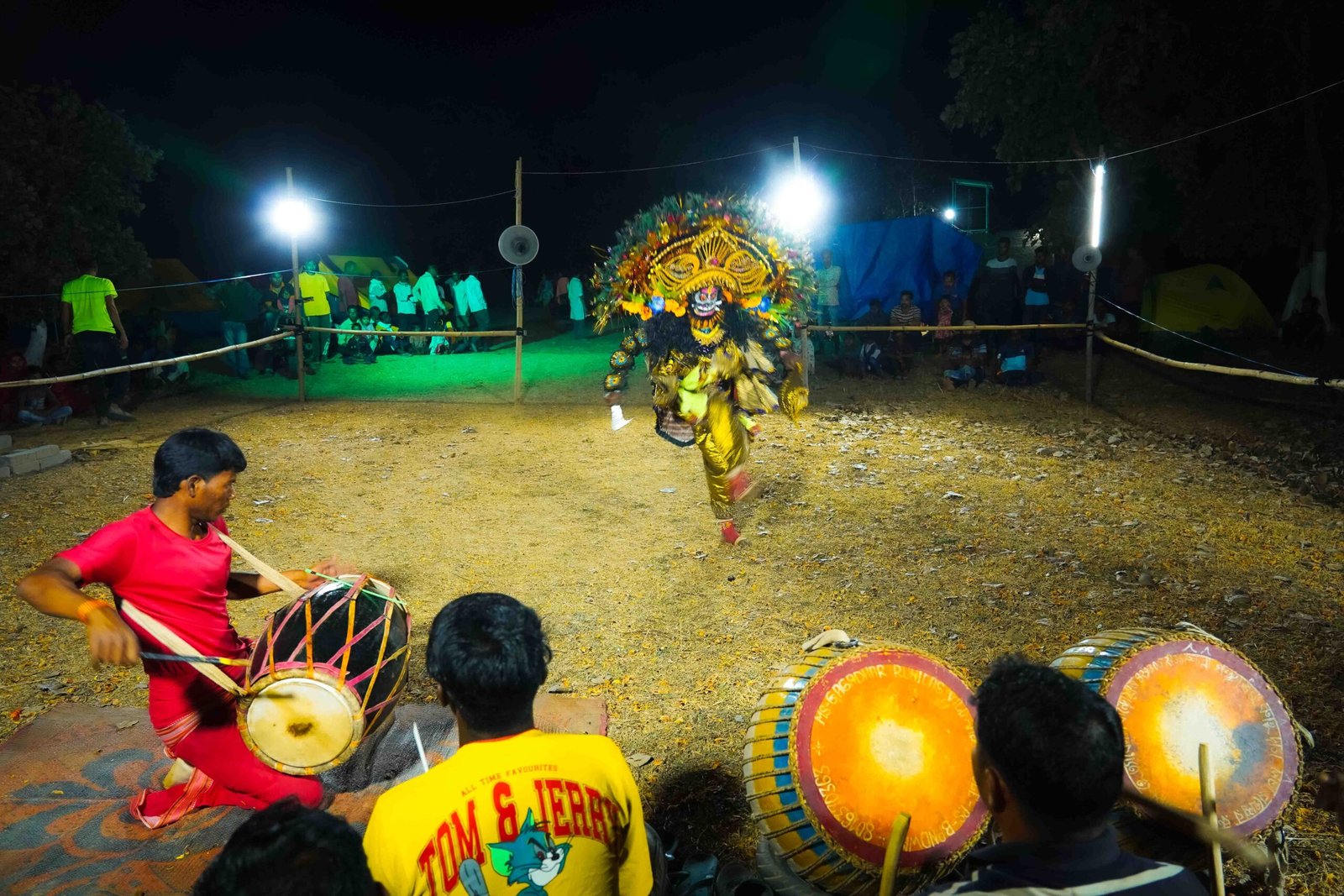
Preserving a Living Tradition: Why It Matters
Chhau is not merely a performance to entertain. It is a carrier of collective memory, ritual, and resistance. Rooted in the rhythms of rural Bengal, especially in the district of Purulia, it connects agricultural life, myth, body movement, and craftsmanship into a singular, visceral art form.
The dancers don’t just perform—they embody the gods, demons, and heroes of ancient epics. When they leap across the stage in their vivid masks and embroidered costumes, they bring alive centuries of folklore, often passed from one generation to the next orally and bodily.
But like many indigenous traditions, Chhau is endangered. The younger generation is tempted toward cities; fewer want to train in a dance form that does not promise steady income or social prestige. Mask-makers in Charida village, once the beating heart of this tradition, now depend on seasonal festivals or bulk orders from decorative craft outlets. The songs and stories—once whispered under banyan trees—are being replaced by smartphone screens.
Yet, every time a Chhau performance takes place in a city auditorium, a college fest, or a visual arts festival, something shifts. A child sees the leap of a dancer and is awestruck. A visitor takes home not just photos but a deep, wordless connection to Bengal’s folk soil.
To preserve Chhau is to preserve imagination.
And that is not a rural issue—it is a cultural urgency that concerns us all.
